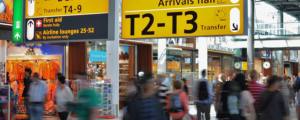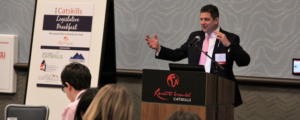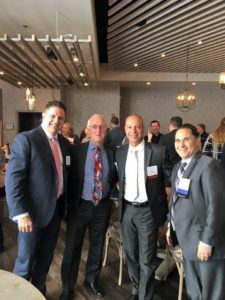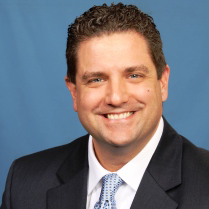Mark Dorr
Episode 77: How Regional Partnerships Keep Tourism Strong, with Mark Dorr
Keeping the engine of New York State tourism humming along doesn’t just happen – it takes the hard work of local tourism boards, big campaigns like “I Love New York,” all of the businesses that cater to visitors, and coordination and cooperation among all of those entities. Keeping a finger on the pulse of all of that is more than a full-time job.
Mark Dorr is president of the New York State Hospitality and Tourism Association, an industry trade group based in Albany. Mark previously served as vice president and communications manager for the group. The association advocates on behalf of the industry before state lawmakers and regulatory agencies and provides educational programs and online marketing exposure.
Mark graduated from the College of Saint Rose with a degree in Public Communications and received his master’s degree in Journalism Public Communications from Murray State University in Kentucky. He previously worked as an editor and feature writer for a publishing company and was the editor of an award-winning weekly newspaper in the Catskills. He also spent three years as an editor-of-record in Troy, New York.
More on Mark’s Background
Thank you for joining me. Mark.
Thank you for having me. I appreciate the opportunity.
I’m looking forward to our conversation, but before we get started, can you share a little bit more about your story and your journey in your own words?
Yes. As you could tell from, from reading my bio, my background is in communications and publishing both in magazines and newspapers, and at some point even years ago, I started to look and say, “You know, the people getting the print and the magazines and the newspapers that seems to be changing a little bit, so maybe I want to get out of that industry and into another one.” Little did I know that it was going to be the tourism industry at the time. I went from newspapers and took a job here at the association as the communications manager handling their publications or online presence, the travel map that we produced. And over the years work myself up to the vice president and then took over a couple of years ago as the president of the organization. A lot of people always ask me, “You’ve been in this group a long time, it’s a tourism association. Why have you stayed so long?” And I always say, “Because it’s one of the most enjoyable and fun associations you can be in because everybody loves tourism.”
So it’s a fun group of people. Hospitality goes from their hotels into our association, to our meetings, to everybody I meet. So it’s been a great fit, I think for myself and I plan to stay for many more years to come.
How to Stand Out From the Crowd
That’s great. I would agree with you. It is an enjoyable and fun, not only association, but industry to be in. So, that’s awesome. I want to dive into some of these questions. We like to focus on creativity and collaboration. The tourism and hospitality industry is very competitive. I’m wondering what you have done or what you’ve seen some of your members do to stand out from the crowd.
Well, we do have a lot of competition from the big destinations you think of Florida, California – they’re always the big areas that people always talk about traveling to. We also have a good bit of competition from your surrounding states. Ohio, Pennsylvania, Maine, they’re all within driving distances from our state. But when you look at all that we have to offer, I think the state sells itself because of the attractions we have. We have Niagara Falls. We have 50 ski areas throughout the state. It’s almost spring, but it’s the winter that won’t end. Here in the Albany area, we had a good foot of snow here yesterday, which is good for the ski areas. You know there’s something for everybody in New York State – wine country, the Adirondacks – there’s a lot to help us stand out.
You have all the breweries throughout the state and then you can go to the Catskills in the summer, and the foliage, and summer on Long Island. Everybody knows how great that is. And of course, New York City is the number one destination in the world. So from my perspective as the Statewide Tourism Association, we have a lot of those great iconic venues to draw people in. We’re not out front in tourism promotion, but we work with a lot of convention and visitors bureaus. We work with the folks at I Love New York. Getting visitors to stay here and do multiple things have really been the cause that the state’s taken up. Especially since Governor Cuomo has taken over and spent millions and millions of dollars on tourism promotion.
So we have a lot of great venues, it’s just spending the money to make sure that people are aware of them outside of New York state. And I have to say over the last eight, ten years, the state has done an increasingly better job of making sure that everybody’s aware statewide of all we have to offer.
Latest Hotel Industry Trends
I would certainly agree with that. You’re in upstate New York, I’m in upstate New York. You mentioned some of those icons including New York City. I would agree that in the last eight to ten years there’s been a lot more brand awareness or just awareness in general of what upstate New York has to offer. I’m wondering during that timeframe Mark, can you talk a little bit about what you’ve seen trending and changing in terms of hotels that you can share with our listeners?
Aside from the big trend, hotel development – it takes three to six years to have a hotel built – one of the things that we’ve seen is a tremendous amount of room inventory for people to stay in.
So it’s interesting because more people are traveling to New York State and staying in cities and towns and counties across the state. But when you look at the hotel occupancy rates, they do drop a little bit year over year because people keep building hotels. Yet even as occupancy might be a little off in certain parts of the state, more rooms are being sold, more people are traveling. So that’s a great trend that will kind of even itself out over time. Some hotels are built, some may transition to a different business. But right now we know more people are traveling because more rooms are being sold in New York State than ever before.
Another great trend which is a benefit to our organization is collaboration among convention and visitors bureaus in any given region. They’ve taken a more regional approach to drawing people to upstate New York, or Long Island, getting visitors coming in for more than just one event or one day. That has done wonders. That has helped everybody throughout the state.
I think that’s a great point as well, to see some of the walls coming down in those territories, and the CVBs working together in that way. I wanted to back up a little bit and talk more about the room inventory and all of the new inventory that’s coming online. Because actually here in the Finger Lakes vacation region, where my office is located, we have pockets of really robust hotel inventory. Then we have pockets of not enough available rooms in the heart of the Finger Lakes. Are you seeing that similarly in other regions within the state where there still is maybe some demand or a need for additional room capacity?
Yes. In some of the rural communities and rural areas where they might have a music festival or an art festival or where the town or the community comes together once or maybe twice a year. There is a need for some areas to get more rooms. But the hotel folks look and say, “Well is it worth building a hotel for those one or two or three events per year?” Meanwhile, everybody has the short-term rentals. There are the Air BnBs of the world and the short-term rentals of the world. There are pockets of the state like you said, that doesn’t have enough room inventory to accommodate multiple day stays for, say a music festival. And that’s when that platform of short-term rental becomes necessary for those communities.
One of the things legislatively that we work on here is at least putting forward some regulations to level that playing field so if communities are having the short-term rental business that at least those people renting out rooms and the host would be able to pay the occupancy taxes, and more importantly for the counties, to pay the sales taxes on those rooms being sold. So there are parts of the state that need extra room inventory. Bringing in a chain hotel is probably not ever going to happen because there’s not enough sustainable business long-term, but there are those short-term rentals that are necessary that we’d like to just see sort of in line a little bit with a bed and breakfast. Because a lot of the bed and breakfasts, because of the short-term rentals not being regulated, have gone out of business.
So it’s a changing landscape all the way around and the industry will be able to figure out a way to do it and accommodate it. But right now, we have a lot of the smaller properties going out of business or being sold or they turn it over to their son or daughter who doesn’t necessarily want to be in the business. A lot of the room inventory in those areas has diminished over the last few years.
That totally makes sense. You’re right it is a changing landscape. I’m wondering if you can also give us some of your perspective on how international travelers fit into this mix. I know it’s been a big focus for the state tourism office in terms of getting some of those international visitors to go outside of New York City and explore more of the state. Are you seeing that with your hotel partners too? Are they seeing more international activity?
Absolutely. I see two parts to this. Twenty years ago, the international travel here in New York State made up about 4 percent of those travelers. Then you go 10 years ago and you probably are up to about 10 percent of the travelers going throughout New York State. Now two years ago the last data that we had, the international traveler represented 21 percent of the travelers coming to New York State spending money. These include the upstate communities and Long Island. It includes Canada, a lot of the Canadian visitors are coming down depending on the strength of the dollar. But the international traveler is a real focus for many regions of the state. And the second part of that is that we’ve done a better job in New York State, and again the governor has done a great job with this.

[bctt tweet=”“Two years ago the last data that we had, the international traveler represented 21 percent of the travelers coming to New York State spending money.” – Mark Dorr #WhyCollaborate #podcast”]
International travelers are flying into New York City. They want to see New York City, and then the push has been getting them to see more of upstate New York. One specific thing has been the millions of dollars the governor has allocated to upgrade the airport in Plattsburgh, New York. I know they’re working in Rochester on upgrades as well. A lot of the airports are gearing up for more branded flights coming in. So they recognize the potential. And the international traveler that comes in is flying in for the most part. So to enhance all of our airports have been a big deal over the last couple of years. I know the governor continues to do that, which we as an association are very happy about. It definitely backs all that infrastructure at the airport that he’s been spending and working on and all the plans look really great.
In fact, I’m in Rochester Friday for a tourism legislative breakfast and one of the big parts of the presentation is going to be on the improvements and the upgrades and all the enhancements that are being done to the Rochester airport.
That’s great. That infrastructure is definitely so important and I’ll be happy to see LaGuardia get that upgrade as well as often as we need to fly in and out of there.
We talk often just about, “If you have the visitors, you’ve got to have the transportation, whether it’s Amtrak or the flights.” All of that is top of mind of the legislators in the state. So it’s been good to recognize the international traveler. When they get here we must be able to move them around.
Absolutely. That’s definitely key. I find those statistics very interesting, just 4% of travelers about 20 years ago were international and as recently as two years ago, that number had jumped to 21%. I’m wondering, Mark, if you have insight on your member hotels and how open they are to working with wholesale rates. I know here in the Finger Lakes vacation region, we talk about needing to get the product online for international visitors. One of the biggest challenges is working with those revenue managers or those general managers at the hotels and getting them under contract with tour operators. Do you have any insight into that?
Well, I know a lot of the hotels here in the Albany area have contracts with multiple groups on the international travel scene. The hotels have been upgrading to more international television stations, more international menus and ordering different things to accommodate travelers that are coming in from many different countries. So the hotels have really embraced it and I always encourage this. The Convention and Visitors Bureaus again, do a great job of connecting with and making sure that the international traveler is aware of what’s going on in those regions or counties. The onus really falls on the hotel owner to make sure they have a good relationship with that Convention and Visitors Bureau. We hear sometimes from our hotels that they feel they are not in the mix with international visitors. What I tell them is go talk to your Convention and Visitors Bureau President and let them know you want to be a part of it.
What you offer, how you’re enhancing the international travelers’ experience, your openness to partnerships where people travel – these are important. You can’t sit over here as a hotel and say, “Well, nobody’s coming to me. I’m not getting any international travelers.” You need to make that connection with the Convention and Visitors Bureau. And that’s the key to making sure that those partnerships and the bus tours and all those things that are coming through. Because I know a lot of the CVBs are really in tune with the bus travel and the tour groups. They’re bringing them in and then they want to find those hotel partners that can show them a great state so visitors will return.

[bctt tweet=”“What you offer, how you’re enhancing the international travelers’ experience, your openness to partnerships where people travel – these are important.” – Mark Dorr #WhyCollaborate #podcast”]
Creative Solutions: Tourism Industry Coalition
Absolutely. I completely agree that the more you can work collaboratively with your CVB locally, the more you can amplify and the more you can stretch budgets and work together, the more people you can reach. That’s just great advice. Well, thank you for letting me take that detour in this conversation because I knew you’d be able to offer our listeners some really good insight into what’s happening.
So, I wanted to circle back to one of these other questions under creativity because it’s one of my favorite ones to ask. Creativity usually appears in the face of some sort of a challenge. I love how creative we can get when we’re trying to problem solve. I’m wondering if there’s a particular challenge that comes to mind for you and if you could share with us kind of the creative solution that maybe came out of that.
From where I sit in our organization, probably the biggest adversity we faced and we had to be a little creative with was the cutting of funding for “I Love New York” and tourism promotion up to the years before Governor Cuomo took over. Every year before that, tourism spending would go down. 5 million, then 4 million, then 3 million. It was just dwindling down. So hotels, amusement parks, bed, and breakfasts all suffered. So creatively we went to work with the CVBs, we created a Tourism Industry Coalition. We meet once a year and go to the capital. But our main issue is making sure that there’s funding for “I Love New York” in the budget.
There’s funding for matching grants, which is a great program many are not aware of. If a region has a marketing plan and says they put together something for $100,000 to market the Finger Lakes region through the Convention and Visitors Bureau, the state will come in and match that hundred thousand dollars. So now you’ve gone from $100,000 to promote what you thought was going to be a great program to $200,000. So we’ve been able to incrementally make sure that the funding is there for, “I Love New York” and the funding is there for the matching grants program. Our current governor spends at least $45,000,000 a year on tourism promotion. In the Catskills and the Adirondacks, the Finger Lakes, It serves to just draw awareness to all the great tourism entities that we have in the states. That was a challenge years ago but we haven’t backed off on the gas at all in that every year we’d give it the same energy, the same emotion to make sure that tourism has continued to be recognized as one of the most important industries.
What people don’t realize, it’s the fourth largest industry in the state as far as employment. So we’re employing a lot of people. In return that creates a great tax base for the state when people are coming in. So tourism is more than just, “Hey, let’s go and have a great time at the ski area and do some fun things in an amusement park.” It also is a job creator. It’s a tax revenue generator, and really just generates a tremendous amount of money for the economy state-wide.

[bctt tweet=”“The travel industry fourth largest industry in the state as far as employment. It is a job creator. It’s a tax revenue generator, and generates a tremendous amount of money for the economy state-wide.” – Mark Dorr #podcast”]
Tourism Industry Coalition
Definitely. I do agree with you, people should understand how much tourism does impact the regional economy. It really is business. Just because it’s not a manufacturing company that’s producing a widget, it has just as much impact on the economy. So I couldn’t agree with you more on that one.
Can you talk a little bit more about the Tourism Industry Coalition? I just participated in your tourism action day. Can you talk a little bit more to our listeners about how the Tourism Industry Coalition is organized and then a little bit about tourism action day and how you approach that?
New York State Hospitality and Tourism Association is a part of the Tourism Industry Coalition. We are the administrator of it, so we kind of put together the framework for some of our issues and our meetings. So we head up that group and get input from all of our members. We’re actually nearing the 30 member mark, which is great. And they pick a couple of issues every year that we lobby on behalf of that group. Two of them I’ve talked about quite a bit since we got on the podcast – the one big one is the matching grants funding in the budget. The other is “I Love New York” funding, which obviously we know, promotes the entire state to both local and international markets.
And this year we had one important issue concerning the school year. There is some talk from the Department of Education and the legislature that they’d like to amend the basic school year and instead of days you kind of make it into hours. In our industry and in New York State and across the country, everybody wants to protect Labor Day because that’s kind of the last day of summer. And then you also have your Memorial Day weekend. So we want to try to make sure that the summer season especially stays intact, and that the school year doesn’t move enough so that it’s sort of infringing on those big family holiday dates. So those were the three big issues we had this year. We work on them year round and we have one lobby day, tourism action day in Albany where we invite a couple of the key legislators to speak.
Senator Funke, who chairs the Senate Tourism Committee, and Assemblymember Danny O’Donnell, who’s the assembly tourism chair came and spoke. They have been great advocates for everything that we are doing and asking for. We also had about a dozen other legislators come down to shake hands and hear about the issues. We do that every year. Next year the organization is growing with its financial backing. So we’re going to probably have a more robust lobby day with big meetings with the important legislators. It’s an important day just to make sure that they continue to understand and are educated about the great impact that tourism has. Some of the things we always tell them, the state and local taxes that tourism generates here is over $8 billion dollars and that’s a huge number when it comes to collecting taxes. And there’s $108 billion in total economic impact when you consider wages and spending and jobs.
I mean, it’s a huge number that tourism contributes. We want to make sure that the legislators remember how important tourism is to the state.
Absolutely. Thanks for explaining that a little bit more because it is a really important component of what we do as an industry within the state. And I think it’s so important to show up and for the legislators just to see us there. And to know that this is so important that we’re coming to see them in Albany, and in their local constituent offices as well. But I think it makes a difference when you take that extra step and actually go to the capital to see them.
I’m glad you said that. One of the things I always encourage people in the industry – make a visit to your legislator. You don’t want to go to your legislator only when you need something, or you’re asking them to stop something, or you need them to help you. It’s relationship building like with any other human being. If you like somebody and you know somebody and you consider them a friend or a colleague, you’re going to listen to them and try to help them out. They don’t want to say, “Okay, I haven’t seen this person in three years, but here they are. They want to make sure I’m giving enough money to tourism funding.”

[bctt tweet=”“You don’t want to go to your legislator only when you need something, or you’re asking them to stop something. It’s relationship building like with any other human being.” – Mark Dorr #WhyCollaborate #podcast”]
So it’s important for our industry to always be in front of them. Even if you’re in a three-room bed and breakfast in the Finger Lakes, it’s important. You’re a business just like any other in the state. I often hear some of the smaller properties say, “Wow, I’m a small property, they don’t want to hear from me.” They do want to hear from any business that’s in their district. Make time one morning per year to go in and thank them or talk to them. Then when you really need something or something’s going wrong, they’re going to be more apt to listen to you and try to react in a positive way.
That’s great advice. And I like the idea of saying, “Okay, once a year I’m just going to get some face time and it’s not going to be for an ask, it’s just for relationship building.” But then when you do have an ask, it’s a lot easier to do that. So that’s really great advice.
So Mark, is there anything that you’re working on now or looking into the future that you’re kind of excited about that you’d like to share with our listeners?
Well, I know it’s on the eastern part of the state and it involved New York City primarily, but one of the projects we’re excited about is the upgrading of the Amtrak rail system that needed to be done. And I know it’s still a work in progress. But the thing we’re most excited about here is being able to enhance the airport, enhance the rail system, just making it as easy as possible for people to move within New York State. And we know that a lot of the millennials don’t travel like we did years ago where the family got in the car and went to a destination and spend a week there.
They do a lot of long weekends. They use a lot of Uber and Lyft and buses and trains and they put their bikes on the train and they go to the Adirondacks. So the travel experience is different. And I think the great thing is, the thing I’m excited about is, the state of New York has realized we need to invest in those areas to be able to move people once they come into New York City and spend their three or four days. To be able to move them upstate or out onto Long Island has been a cause of ours to make with the government and with the governor. And they’ve realized that. So moving people around to the great destinations we have to offer is exciting for us.
Coopetition: Catskills
That is very exciting. So now switching gears a little bit, I’m wondering if you have some examples of something I like to call coopetition where you work with perceived competitors. So maybe some of those CVBs that you talked about actually come together to create something bigger than they can do on their own. I’m wondering if you have any specific examples that you can share with us where you’ve seen this kind of coopetition really work.
I will give one great example in the Catskills. They all have their separate DMOs and TPAs and CVBs in the different counties, and for years they were all doing their own thing. Several years ago they got together and said, “Wait a minute, we all represent the Catskill region.” So the counties of Delaware, Green, Ulster, and Sullivan Counties got together and formed their own parent group. They’re still all separate and do all their own work, but they do market together as a group and they’re called CATS, C-A-T-S. Those four regions get together and they collaborate and they market the region as a whole. And there are other parts of the state doing that and following a similar model, which is great.
I know that Rochester in your area has a relationship with the Buffalo area and Corning. So those three organizations work together. They have a program and bring people in so you can see different things in those three locations, but they’re all marketed as one.
They’re doing a great job of looking at it regionally and saying we all have distinct great things that we have to offer. But again, it goes back to what we talked about in the very beginning. We have to get them to the region first. So get them into the region and then they’ll go to all the different places to see all the great venues. The Catskills, I think was the first really to do it, and they’re known statewide and they have a legislative reception down in that area. That legislative reception is not just for one CVB, it’s for that group of four counties as they put forth their regional message.
That’s great. That’s a wonderful example. I think the more regions can get together, the stronger they are. But I also like your example of the Rochester, Buffalo, Niagara region kind of working together with Corning and the Finger Lakes, because that goes to what we started this whole conversation with, which is not only getting them here first, but then getting them to stay longer and giving them more reason to stay longer. And so I think those are two really perfect examples.
The Rochester, Corning, Buffalo, Niagara partnership has a great three-word slogan. Do you know what it is?
Yes. It’s Wine, Water, and Wonders. It’s their international project.
That’s right. So you got three words and that’s how good their slogan is. It’s good because it is short, it is concise. I’m not out to that part of the state enough, but I know it’s been talked about as a great collaboration. And Buffalo, Niagara, and Rochester are not super close to one another, but they have put those dots together and made that something interesting and attractive. So that type of thinking excites our organization too.
Best Practices for Collaborations and Partnerships
Yes, they are close enough but they are actually far enough away that you’re going to get multiple overnights and it’s not going to be necessarily a hub and spoke kind of thing. You’re going to move from one location. You’re right. That’s a really great example.
So before we wrap up Mark, I knew we’d have a great conversation. There’d be no shortage of things to talk about. But before I let you go, I would like to ask you one last question: Do you have any advice for our listeners when they are thinking about collaborations or partnerships? Any kind of best practices that can help them be successful?
This is going to be a little bit out of the box, but when you look at how Catskills has done it and you look at how the Rochester, Buffalo, Niagara, and Corning folks have done it, I think before you begin collaborating, what I’ve heard from some of these folks is you kind of have to sit down and have a vision of the end goal once the collaboration is complete. What are you trying accomplish? And then when you’re collaborating on all these tourism issues, you figure out what you want to accomplish, and then you put together the roadmap of how to get there. When everyone is working on their own, they have their pet projects. But when you look at collaboration, you’re going to have to give a little and have an overarching plan together. That’s the thing, the end result and who’s the core group that you want to market to, to make sure they come in and find the experiences.

[bctt tweet=”“When you look at collaboration, you’re going to have to give a little and have an overarching plan together.” – Mark Dorr #WhyCollaborate #podcast”]
I think that’s great advice, having that vision. I like how you put it, that you need a vision for the end result, where you’re trying to get to, and then you build your roadmap after you know where you’re going. And then that follow-up point about, who is your target audience, or who do you want to market to, is also a great point. So Mark, thank you so much for being with us today. We’ve learned a lot from you and I’m sure we’ll have an opportunity perhaps to have you back on the show again at some point and talk about what’s new and what’s happening. But thank you so much for being here today.
You’re welcome. I’ll come back anytime and thank you very much for having me.
We value your thoughts and feedback and would love to hear from you. Leave us a review on your favorite streaming platform to let us know what you want to hear more of. Here is a quick tutorial on how to leave us a rating and review on iTunes!







